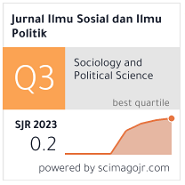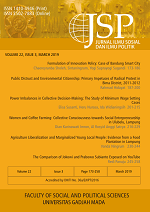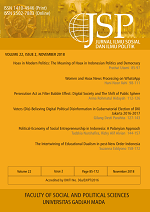Hoax in Modern Politics: The Meaning of Hoax in Indonesian Politics and Democracy
Pratiwi Utami(1*)
(1) School of Media, Film, and Journalism, Faculty of Arts, Monash University
(*) Corresponding Author
Abstract
The propagation of hoaxes on social media has contributed to political tension in many countries. The 2016 US presidential election provides evidence of how fake news can generate more social media engagement than real news. In multicultural Indonesia, the history of anti-communist, anti-Christian, and anti-Chinese pogroms increases the level of sensitivity and sentiment, especially when dealing with racial issues. This paper explores the role of hoaxes in Indonesia’s contemporary politics. It investigates the characteristics of hoax information circulated on social media during the 2017 Jakarta election using a memetic practice approach. This study perceives hoaxes as having acted like memes in terms of the ways in which they dismantle existing source material to tap into ideas or sentiments people connect with. Hoaxes as memes alter original items into new forms of artifacts, with new messages that resonate with existing beliefs in society. Consequently, hoaxes can create a culture based on a shared belief among the community and, in the era of increasing polarization, a hoax has the potential to be a means of political partisanship. However, with the tendency to overpower the truth and lead people away from believing facts, hoaxes can be a threat to participatory democracy.
Keywords
Full Text:
PDFReferences
Al Jazeera. (2016, May 30). Facebook: Social media platform or news gatekeeper?. Retrieved from http://www.aljazeera.com/programmes/listeningpost/2016/05/facebook-social-media-platform-news-gatekeeper-160529095125515.html
Anisa, R., & Rachmaniar. (2016). Hoax politik pada media sosial Instagram (Studi Etnografi Virtual Tentang Keberadaan Instagram dan Hoax Politik). In Prosiding Seminar Nasional Komunikasi 2016. Retrieved from http://jurnal.fisip.unila.ac.id/index.php/prosidingkom/article/download/281/181
BBC Indonesia. (2016, November 17). Pidato di Kepulauan Seribu dan hari-hari hingga Ahok menjadi tersangka [Kepulauan Seribu speech and the days till Ahok become the suspect]. Retrieved from http://www.bbc.com/indonesia/indonesia-37996601
Chen, Y., Conroy, N. J., & Rubin, V. L. (2015). News in an online world: The need for an “automatic crap detector”. Proceedings of the Association for Information Science and Technology, 52(1), 1-4. doi:10.1002/pra2.2015.145052010081
Colón, A. (2017, February 07). You are the new gatekeeper of the news. Retrieved from https://theconversation.com/you-are-the-new-gatekeeper-of-the-news-71862
Dawkins, R. (1976). The Selfish Gene. London: Oxford University Press.
Firmansyah, R. (2017). Web Klarifikasi Berita Untuk Meminimalisir Penyebaran Berita Hoax. Jurnal Informatika, 4(2), 230-235. doi:https://doi.org/10.31311/ji.v4i2.2138
Kusman, AP. (2017, January 19). Hoaxes and fake news: a cancer on Indonesian democracy. Indonesia at Melbourne. Retrieved from http://indonesiaatmelbourne.unimelb.edu.au/hoaxes-and-fake-news-a-cancer-on-indonesian-democracy/
MacDougall, CD. (1958). Hoaxes. New York: Dover Publications.
Mallonee, L. (2017, October 04). That Flag-Burning NFL Photo Isn't Fake News. It's a Meme. Retrieved from https://www.wired.com/story/that-flag-burning-nfl-photo-isnt-fake-news-its-a-meme/
MASTEL. (2017). Infografis Hasil Survey MASTEL Tentang Wabah HOAX Nasional [Infographic of MASTEL survey result of national epidemic of HOAX]. Retrieved from http://mastel.id/infografis-hasil-survey-mastel-tentang-wabah-hoax-nasional/
Nugroho, SE. (2017). Upaya Masyarakat Anti Fitnah Indonesia Mengembalikan Jatidiri Bangsa dengan Gerakan Anti Hoax [The efforts from Anti-Defamation Society of Indonesia to bring back national identity through the Anti-Hoax Movement]. Paper presented at Konferensi Nasional Peneliti Muda Psikologi Indonesia [National Conference of Indonesian Young Researcher on Psychology], 20-22 April, Jakarta, Indonesia. Retrieved from http://proceedings.psikologi.uhamka.ac.id/index.php/prosiding/article/view/231/2
Pakpahan, R. (2017). Analisis fenomena hoax diberbagai media sosial dan cara menanggulangi hoax [Analysis of hoaxes on social media and how to fight them]. Paper presented at Konferensi Nasional Ilmu Sosial & Teknologi KNiST, March, 479-484. Retrieved from http://seminar.bsi.ac.id/knist/index.php/knist/article/view/474/328
Renaldi, A. (2017, August 26). Saracen Is Shut Down. But Can We Ever Really Beat Fake News?. Vice. Retrieved from https://www.vice.com/en_id/article/3kk7v5/saracen-has-been-shut-down-but-can-we-ever-really-beat-fake-news.
Sheikh, A. A. (2016, December 11). The media in the post-truth era. Retrieved from http://www.aljazeera.com/indepth/opinion/2016/12/media-post-truth-era-161210125419198.html
Shifman, L 2014, Memes in Digital Culture, MIT Press, USA.
Situngkir, H. (2011). Spread of Hoax in Social Media. BFI Working Paper, No. WP-4-2011. doi: 10.2139/ssrn.1831202
van Dijck, J & Poell, T. (2013). Understanding social media logic. Media and Communication, 1(1), 2-14. doi: 10.12924/mac2013.01010002
Vicario, M. D., Bessi, A., Zollo, F., Petroni, F., Scala, A., Caldarelli, G., . . . Quattrociocchi, W. (2016). The Spreading of Misinformation Online. In Proceeding of National Academy of Sciences (3rd ed., Vol. 113, pp. 554-559). Washington: National Academy of Sciences. doi:https://doi.org/10.1073/iti0316113
Wardani, MMS. (2017). Manipulasi bahasa dalam teror kabar bohong (hoax) [The manipulation of language in the terror of hoaxes]’. Seminar paper, Faculty of Literature, Sanata Dharma University Yogyakarta, 26 April. Retrieved from https://www.usd.ac.id/fakultas/sastra/sasing/f1l3/Dies%2024/Manusia%20Bahasa%20dalam%20Teror%20Hoax.pdf
Article Metrics
Refbacks
- There are currently no refbacks.
Copyright (c) 2019 Jurnal Ilmu Sosial dan Ilmu Politik

This work is licensed under a Creative Commons Attribution-NonCommercial-NoDerivatives 4.0 International License.






















